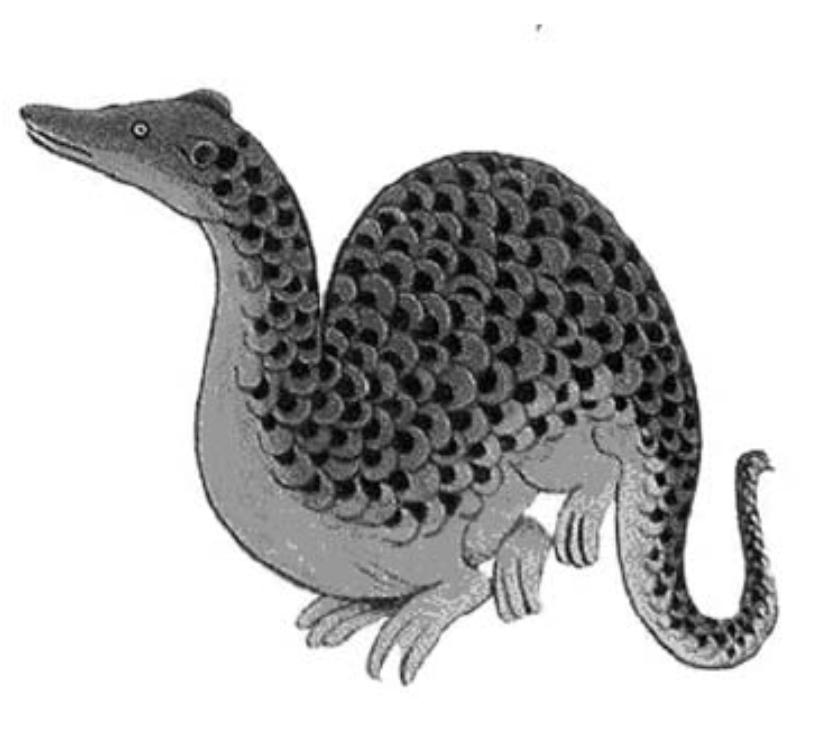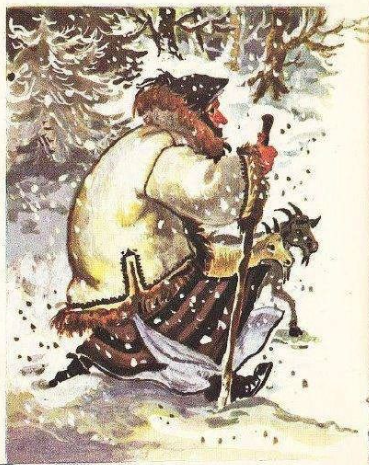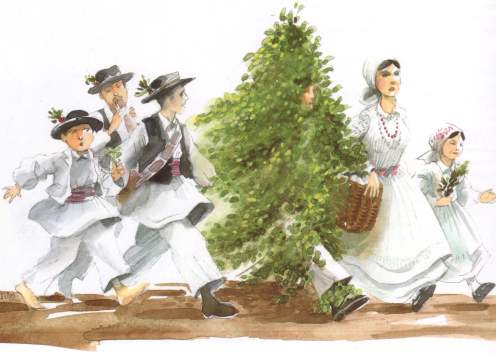
#FolkloreThursday Thread: The legend about the pozoj (dragon in local dialect) from Čičanjska Jama (jama here meaning marsh, lake, river tributary) near Donji Vidovec, Međimurje, Croatia: 

It was long known that there was a pozoj (dragon) in Čičanjska Marsh whose tail was under the Church. [In the legends from the area, dragons were always huge, always lived under ground and always had a tail under some church]
Namely, when the pozoj (dragon) turned over in the marsh, all the candles fell of the altar in the Church. It happened once that a young gentleman dressed in a black suit came to the village. He went to the parish house and talked at length there with the parish priest...
Then the parish priest called the sacristan, who led that man to Čičanjska Marsh. That man carried a large book under his arm. He was a grabancijaš [literally black scholar, black student, man in black 🙂 the only person who can control and defeat pozojs (dragons)]...
When they reached the marsh, he went very close to it, and stood on the root of an alder shrub and started thus to read from the book. The sacristan hid a little further away in the reeds and watched all that was happening...
All of a sudden the water started to be disturbed and a pozoj’s (dragon's) head appeared. The grabancijaš (black student, man in black) then grabbed a golden bridle and threw it over the pozoj (dragon). And he kept on reading from the book...
When the pozoj’s (dragon's) body was half out of the water, the grabancijaš (black student, man in black) jumped upon him and rode him to the south. Thee pozoj (dragon) had such a long tail that he dragged one part of it along the ground as he flew...
Suddenly a wind came up, it clouded over and hail began to fall, as fat as a walnut, so that it destroyed everything from the Dravica Stream to the Drava River...
The shepherds on the upland pasture grazing their cows could clearly see the pozoj’s (dragon's) tail as well as his rear legs. The reverend parish priest said later that the grabancijaš (black scholar, man in black) had ridden the pozoj (dragon) to Africa...
In this legend we see that as soon as grabancijaš (black student, man in black) rides the pozoj (dragon) away, hail storm starts which destroys the village land...
The author of the paper researchgate.net/publication/33… wrongly believes that it is grabancijaš (black student, man in black) who causes the hailstorm...
It is actually his action of taking the dragon away that causes the hailstorm... Because it was dragon that protected the village from the hailstorms and other bad weather...This is a common mythological theme found in the Balkans among South Slavs...
Bulgarians, Serbs and Macedonians believed that it was male dragons (of a fire breathing kind) called "zmaj" which protected their territory from evil female dragons called "ala", whose main activity was to lead storm and hail clouds over fields to destroy crops...
Whenever a "zmaj" (male dragon) noticed an "ala" (female dragon) approaching, he would fly up into the clouds to fight against her and chase her away. He shot fiery arrows and stones at her, which produced lightning and thunder...
Zmaj (male dragon) was benevolent toward the humans, and he took care that his territory received the right amount of rain at the right time, for good growth of the crops...
If a village didn't have its own "zmaj" (male dragon), it had its "zmajeviti čovek" (dragon man). The dragon man was believed to posses the same supernatural powers possessed by a dragon and to act similar to the dragon when it came to bad weather and especially hailstorms...
As soon as he saw bad weather approaching, which he knew was brought by an ala (evil female dragon), the dragon man would leave whatever he was doing, and fly up to confront the demon...
This he did by falling into a deep sleep, or entering a state similar to death, usually at the very spot where he happened to be at that time. His soul then left his body in the form of a snake, and soared skywards to confront the ala inside the hailstorm clouds...
It was claimed that he was not breathing as long as his soul was absent from his body. The battle could last for a whole day, or even for several days, during which time the man lay unconscious, sweating profusely from the exertion of the fight...
He should not be pushed or moved while in this state: if he was not in the same position as when he fell asleep, his soul would not be able to return into his body, and he would die...
Now here is an interesting twist: in some regions of Serbia, people believed that it was actually ala (female dragon) which was connected to a territory, which she defended against attacks by the ale (female dragons) from other territories...
In the past, in the villages that now form part of the city of Kruševac, Serbia, when blessings were pronounced on Christmas Eve, the villagers would also say, "God, save our guardian ala"...
People interpreted hail ravaging their crops as a defeat of their ala (female dragon) by an ala (female dragon) from elsewhere. The victorious ala (female dragon) would loot the crop yield of the ravaged area, and transfer it to her own territory...
Further twist: in Banat and some areas of eastern Serbia, the dragon men were referred to as "alovit". This adjective is derived from the noun ala, and means "being like ala, having supernatural properties"...
In these areas people believed that an alovit man can gather a hailstorm and guide it to the fields of another village in order to destroy them...
But they also protected their village from these attacks At the sight of hail clouds, the alovit man would fall into a trance-like sleep. His soul would then fly up to the clouds, where he would fight the soul of the alovit man who created and guided the storm...
So...Back to the original story...The grabancijaš (black student, man in black), takes the dragon (the protector from hail) away, and the hail destroys the village land...
However, in Slovenian legends the grabancijaš (black student, man in black) drives out the dragon because the dragon causes the stormy weather or the serious weather predicament...This is obviously not a dragon, but an ala...
Interstingly in Slovenia, the dragon fighter is known as Kresnik (Fiery one, from kres=fire)...This is very important, you'll why soon...A fiery being just like dragon, who fights alas....
In Hungarian folk legends, garabonciás was believed to be capable of whipping up storms or hail showers, or alternatively, of driving them away. Just like in Serbia...
Hungarians believe the same about dragons, too. They can create storms or hail showers, or alternatively, drive them away. Except that Hungarians forgot that hailstorms are created by female dragons (ala) and that the dragons that drive hailstorms away are male dragons (zmaj)...
You can find a lot more interesting stuff about male and female dragons, dragons men and weather here en.wikipedia.org/wiki/Zduha%C4%… and here en.wikipedia.org/wiki/Ala_(demo… But one thing that has always intrigued me was "the sexism of these legends" 🙂
It is female dragons who are causing hailstorms and other bad weather that destroys the crops and takes fertility from the land...
Even when they are protecting their territory, they are still doing this by steering the hailstorms and bad weather over neighboring land and destroying their crops and stealing their land's fertility...
The male dragons on the other hand, fight the hailstorms and destroy the hail clouds, turning destructive hail into beneficial rain...They protect their land and ensure "that it gets the right amount of water at the right time"...
Why? Why is it the female dragon which creates bad weather, and why are female dragons specifically associated with hail (ice) storms? Because:
https://twitter.com/serbiaireland/status/1224330519011307520
Hailstorms can cover the land in layer of ice...In the middle of summer...So if anyone is in these deadly clouds full of ice, it must be Baba (The Old Hag)...(The Spirit, Soul) of Winter Earth...The Ice Dragoness...Ala...
oldeuropeanculture.blogspot.com/2019/11/baba-c…
oldeuropeanculture.blogspot.com/2021/01/tanngn…
oldeuropeanculture.blogspot.com/2019/11/baba-c…
oldeuropeanculture.blogspot.com/2021/01/tanngn…

And who is the one who kills the death bringing Old Hag of winter and transforms here into the life giving Young Maiden of spring? Well sun of course...The fiery one (Slovenian Kresnik)...Also known as Jarilo (The fiery on, from jar=raging fire)...Slavic young sun god...
Guess what? Jarilo is the dragon, the fire breathing one...He is personification of the sun's heat...Which can be beneficial (when it warms the earth and melts the ice) and destructive (when it dries the earth and "steals the waters")
https://twitter.com/serbiaireland/status/1374144809892511749
Which is why it is the fire breathing male dragon "zmaj" (symbol of sun's heat, summer) which fights ice breathing female dragon "ala" (symbol of earth coldness, winter)...
I wish my village of Blackrock was in Serbia, where it would have its own zmaj (fire breathing male dragon) who would protect my poor flowers from the pesky ala (female dragon who live in hail clouds)...Or that the Irish know about anti hail rockets, the next best thing...
The end...
• • •
Missing some Tweet in this thread? You can try to
force a refresh














